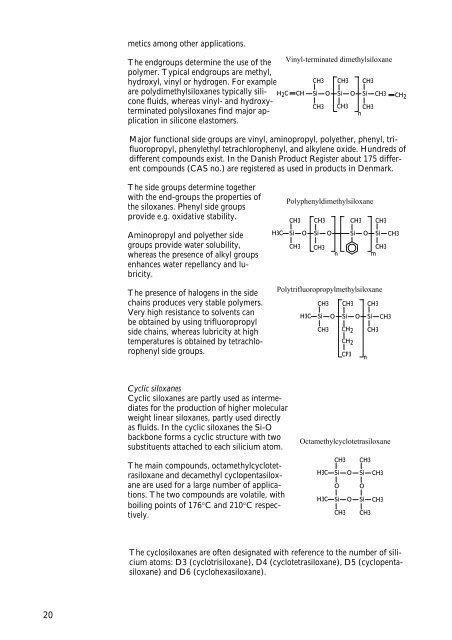No. 1031 - Miljøstyrelsen
No. 1031 - Miljøstyrelsen
No. 1031 - Miljøstyrelsen
Create successful ePaper yourself
Turn your PDF publications into a flip-book with our unique Google optimized e-Paper software.
20<br />
metics among other applications.<br />
The endgroups determine the use of the<br />
polymer. Typical endgroups are methyl,<br />
hydroxyl, vinyl or hydrogen. For example<br />
are polydimethylsiloxanes typically silicone<br />
fluids, whereas vinyl- and hydroxyterminated<br />
polysiloxanes find major application<br />
in silicone elastomers.<br />
Major functional side groups are vinyl, aminopropyl, polyether, phenyl, trifluoropropyl,<br />
phenylethyl tetrachlorophenyl, and alkylene oxide. Hundreds of<br />
different compounds exist. In the Danish Product Register about 175 different<br />
compounds (CAS no.) are registered as used in products in Denmark.<br />
The side groups determine together<br />
with the end-groups the properties of<br />
the siloxanes. Phenyl side groups<br />
provide e.g. oxidative stability.<br />
Aminopropyl and polyether side<br />
groups provide water solubility,<br />
whereas the presence of alkyl groups<br />
enhances water repellancy and lubricity.<br />
The presence of halogens in the side<br />
chains produces very stable polymers.<br />
Very high resistance to solvents can<br />
be obtained by using trifluoropropyl<br />
side chains, whereas lubricity at high<br />
temperatures is obtained by tetrachlorophenyl<br />
side groups.<br />
Cyclic siloxanes<br />
Cyclic siloxanes are partly used as intermediates<br />
for the production of higher molecular<br />
weight linear siloxanes, partly used directly<br />
as fluids. In the cyclic siloxanes the Si-O<br />
backbone forms a cyclic structure with two<br />
substituents attached to each silicium atom.<br />
The main compounds, octamethylcyclotetrasiloxane<br />
and decamethyl cyclopentasiloxane<br />
are used for a large number of applications.<br />
The two compounds are volatile, with<br />
boiling points of 176°C and 210°C respectively.<br />
H2C CH Si O Si O Si CH3 CH2<br />
The cyclosiloxanes are often designated with reference to the number of silicium<br />
atoms: D3 (cyclotrisiloxane), D4 (cyclotetrasiloxane), D5 (cyclopentasiloxane)<br />
and D6 (cyclohexasiloxane).<br />
H3C<br />
Vinyl-terminated dimethylsiloxane<br />
H3C<br />
CH3<br />
CH3<br />
Polytrifluoropropylmethylsiloxane<br />
CH3<br />
Si<br />
CH3<br />
O<br />
CH3<br />
CH3<br />
CH3<br />
Si<br />
CH2<br />
CH2<br />
CF3<br />
CH3<br />
n<br />
O<br />
CH3<br />
Polyphenyldimethylsiloxane<br />
CH3<br />
Si<br />
CH3<br />
O<br />
CH3<br />
Si O<br />
CH3<br />
H3C<br />
H3C<br />
n<br />
CH3<br />
Si<br />
O<br />
Si<br />
CH3<br />
O<br />
O<br />
CH3<br />
Si O<br />
n<br />
CH3<br />
O<br />
CH3<br />
Si CH3<br />
CH3<br />
Octamethylcyclotetrasiloxane<br />
Si CH3<br />
Si CH3<br />
CH3<br />
CH3<br />
Si CH3<br />
CH3<br />
m

















